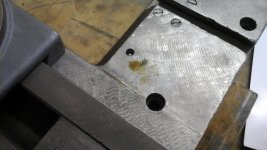mvernon
Plastic
- Joined
- Feb 10, 2019
- Location
- Pennsylvania
I have been working on repainting my bridgeport. I seem to be having problems with my 3M Platinum Filler not adhering to the bare cast iron. The process i have used so far is -
1. Purple power degreaser
2. Wire Wheel all paint and bondo off
3. Purple Power Degreaser
4. EastWood After Blast to prevent flash rust
5. Acetone to remove After blast and clean for Filler
6. Apply Filler
I was concerned about adhesion so I did some test spots. When scratched it seems to flake off. I know that everyone says put epoxy primer on first. But the filler should still be sticking to cast iron even if it isn't ideal. Does 3m not adhere to cast iron? Do I need to switch to a different filler? I still have practically a whole gallon as it was bought just for the bridgeport.
1. Purple power degreaser
2. Wire Wheel all paint and bondo off
3. Purple Power Degreaser
4. EastWood After Blast to prevent flash rust
5. Acetone to remove After blast and clean for Filler
6. Apply Filler
I was concerned about adhesion so I did some test spots. When scratched it seems to flake off. I know that everyone says put epoxy primer on first. But the filler should still be sticking to cast iron even if it isn't ideal. Does 3m not adhere to cast iron? Do I need to switch to a different filler? I still have practically a whole gallon as it was bought just for the bridgeport.



